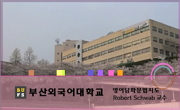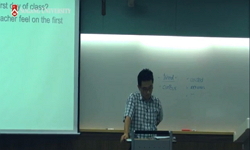This paper was based on the GBN (Given-Before-New)principle; a definite noun phrase is considered to have a given information so it should be in front of the indefinite noun phrase. Korean L2 learners, however, can’t recognize this theory so they do...
http://chineseinput.net/에서 pinyin(병음)방식으로 중국어를 변환할 수 있습니다.
변환된 중국어를 복사하여 사용하시면 됩니다.
- 中文 을 입력하시려면 zhongwen을 입력하시고 space를누르시면됩니다.
- 北京 을 입력하시려면 beijing을 입력하시고 space를 누르시면 됩니다.
https://www.riss.kr/link?id=A100752371
- 저자
- 발행기관
- 학술지명
- 권호사항
-
발행연도
2015
-
작성언어
Korean
- 주제어
-
등재정보
KCI등재
-
자료형태
학술저널
- 발행기관 URL
-
수록면
211-233(23쪽)
-
KCI 피인용횟수
1
- DOI식별코드
- 제공처
-
0
상세조회 -
0
다운로드
부가정보
다국어 초록 (Multilingual Abstract)
This paper was based on the GBN (Given-Before-New)principle; a definite noun phrase is considered to have a given information so it should be in front of the indefinite noun phrase. Korean L2 learners, however, can’t recognize this theory so they don’t appreciate the different meanings of the two dative constructions(double object construction and the prepositional dative construction) in the context and they don’t have any perception like L1 speakers. That’s because Korean L2 learners studied that two dative constructions are alike. so this paper would like to motivate to find more effective way to understand two dative constructions.
목차 (Table of Contents)
- Ⅰ. 서론
- Ⅱ. 이론적 배경
- Ⅲ. 연구 방법
- Ⅳ. 연구 결과 분석
- Ⅴ. 결론
- Ⅰ. 서론
- Ⅱ. 이론적 배경
- Ⅲ. 연구 방법
- Ⅳ. 연구 결과 분석
- Ⅴ. 결론
- 인용문헌
참고문헌 (Reference)
1 Givon, T, "qMind, code, and context: Essays in pragmatics" Laurence Erlbaum 1989
2 Levin, B, "Verb and Constructions" University of Southern California 2004
3 Givon, T, "Towards a Theory of Grammatical Relations" Academic Press 151-182, 1984
4 Fuller, J, "Topic- Prominance in Interlanguage" 37 : 1-18, 1987
5 Cowan, R, "The Teacher’s Grammar of English: A Course Book and Reference Guide" Cambridge University Press 2008
6 Wierzbicka, A, "The Semantics of Grammar" John Benjamins Publishing Company 1988
7 Carroll, M, "The Relecance of Information Organization to Second Language Acquisition Studies: The Descriptive Discourse of Advanced Adult Learners of German Studies" 22 : 441-466, 2000
8 Synder, K, "The Relationship between Form and Function in Ditransitive Constructions" University of Pennsylvania 2003
9 Marefat, H, "The Impact of Information Structure as a Discourse Factor on The Acquisition of Dative Alternation by L2 Learner" 59 (59): 66-82, 2005
10 Arnold, E, "The Effect of Structural Complexity and Discourse Status" 76 : 28-55, 2000
1 Givon, T, "qMind, code, and context: Essays in pragmatics" Laurence Erlbaum 1989
2 Levin, B, "Verb and Constructions" University of Southern California 2004
3 Givon, T, "Towards a Theory of Grammatical Relations" Academic Press 151-182, 1984
4 Fuller, J, "Topic- Prominance in Interlanguage" 37 : 1-18, 1987
5 Cowan, R, "The Teacher’s Grammar of English: A Course Book and Reference Guide" Cambridge University Press 2008
6 Wierzbicka, A, "The Semantics of Grammar" John Benjamins Publishing Company 1988
7 Carroll, M, "The Relecance of Information Organization to Second Language Acquisition Studies: The Descriptive Discourse of Advanced Adult Learners of German Studies" 22 : 441-466, 2000
8 Synder, K, "The Relationship between Form and Function in Ditransitive Constructions" University of Pennsylvania 2003
9 Marefat, H, "The Impact of Information Structure as a Discourse Factor on The Acquisition of Dative Alternation by L2 Learner" 59 (59): 66-82, 2005
10 Arnold, E, "The Effect of Structural Complexity and Discourse Status" 76 : 28-55, 2000
11 Mazurkewich, I, "The Acquisition of the Dative Alternation by Second Language Learners and Linguistic Theory" 34 (34): 91-108, 1984
12 Berwick, R, "The Acquisition Syntactic of Knowledge" MlT Press 1985
13 Givon, T, "Syntax and Semantics 12: Discourse and Syntax" Academic Press 1979
14 Creidier, C, "Syntax and Semantics" 3-22, 1979
15 박분주, "Structure Persistence in L1 and L2 Production of English Dative Structure" 언어과학회 (46) : 127-143, 2008
16 Clifton, Jr., C, "Should Given Information Appear Before New" 32 : 886-895, 2004
17 Green, G, "Semantics and Syntactic Regularity" Indiana University Press 1974
18 Krifka, Manfred, "Semantic and Pragmatic conditions for the Dative Alternation" 한국영어학회 4 (4): 1-31, 2004
19 Bresnan, J, "Reality Exploration and Discovery: Pattern Interaction in Language and Life" CSLI 161-184, 2009
20 Prince, E, "Radical Pragmatics" Academic Press 223-254, 1981
21 Clark, H, "Psychology and Language" Harcourt, Brace Jovanovich 1977
22 Wasow, T, "Postverbal Behavior" CSLI Publications 2002
23 Bresnan, J, "On the Gradience of The Dative Alternation" Stanford University 2003
24 Larson, R, "On the Double Object Construction" 19 (19): 35-391, 1988
25 Prince, E, "Linguistic Theory: Extensions and Implications" Cambridge University Press 1988
26 최혜원, "Length and Order: A Corpus Study of Korean Dative-Accusative Construction" 담화·인지언어학회 14 (14): 207-227, 2007
27 Lee, D.-H, "Learning of English Dative Structures by Korean College Students and the Operation of Learning Principles" 55 (55): 331-350, 2000
28 Pinker, S, "Learnability and Cognition: The Aquisition of Argument Structure" MIT Press 1989
29 Rutherford, W, "Language Transfer in Language Learning" Newbury House 358-371, 1983
30 Stevens, J, "Information Structure, Grammar and Strategy in Discourse" University of Pennsylvania 2013
31 Lambrecht, K, "Information Structure and Sentence Form: Topic, Focus and the Mental Representations of Discourse Referents" Cambridge University Press 1994
32 Gundel, K, "Information Structure and Referential Giveness / Newness: How Much Belongs in Grammar" CSLI Publications 2003
33 Shin, K.-Y, "Iconicity-theoretic and Corpus-Based Analysis on the Asymmetrical Dative Constructions of English" University of Yonsei 2003
34 Kim, H.-S, "Harvard Studies in Korean Linguistics 10" 76-83, 2004
35 Allerton, D, "Generating Indirect Object in English" 14 (14): 21-33, 1978
36 Levin, B, "English Verb Classes and Alternations" University of Chicago Press 1993
37 Conwell, E, "Early Syntactic Productivity: Evidence from Dative Shift" 103 : 163-179, 2007
38 Erteschik-Shir, N, "Discourse and Syntax (Syntax and Semantics 12)" Academic Press 441-447, 1979
39 Clark, H, "Discourse Production and Comprehension" 1 : 1-40, 1977
40 Goldberg, A, "Constructions: A Construction Grammar Approach to Argument Structure" The University of Chicago Press 1995
41 Callies, M, "Argument Realisation, Information Status and Syntactic Weight–A Learner Corpus Study of The Dative Alternation" Niemeyer 2008
42 Yeo, I.-K, "A Study on the Preference for English Dative Alternations and the Learnability of Korean Students" Korea National University of Education 2012
43 Kwon, Y.-S, "A Study on the Asymmetrical Dative Constructions of English on the Basis of the Principle of End Weight" Korea National University of Education 2013
44 Bresnan, J, "A Few Lessons from Typology" 11 (11): 2007
동일학술지(권/호) 다른 논문
-
Wallace Stevens’ Hidalgo in a “most unpropitious place”
- 새한영어영문학회
- Thompson, Erik Robb
- 2015
- KCI등재
-
- 새한영어영문학회
- 김대익(Kim, Dae-IK)
- 2015
- KCI등재
-
- 새한영어영문학회
- 김석훈(Kim, Sok-Hun)
- 2015
- KCI등재
-
- 새한영어영문학회
- 손광락(Son, Gwangrak)
- 2015
- KCI등재
분석정보
인용정보 인용지수 설명보기
학술지 이력
| 연월일 | 이력구분 | 이력상세 | 등재구분 |
|---|---|---|---|
| 2026 | 평가예정 | 재인증평가 신청대상 (재인증) | |
| 2020-01-29 | 학술지명변경 | 외국어명 : The New Korean Journal of English Lnaguage & Literature -> The New Korean Journal of English Language & Literature |  |
| 2020-01-01 | 평가 | 등재학술지 유지 (재인증) |  |
| 2017-04-21 | 학회명변경 | 영문명 : 미등록 -> The New Korean Association of English Language and Literature |  |
| 2017-01-01 | 평가 | 등재학술지 유지 (계속평가) |  |
| 2013-01-01 | 평가 | 등재학술지 유지 (등재유지) |  |
| 2010-01-01 | 평가 | 등재학술지 유지 (등재유지) |  |
| 2008-01-01 | 평가 | 등재학술지 유지 (등재유지) |  |
| 2005-01-01 | 평가 | 등재학술지 선정 (등재후보2차) |  |
| 2004-01-01 | 평가 | 등재후보 1차 PASS (등재후보1차) |  |
| 2003-01-01 | 평가 | 등재후보학술지 선정 (신규평가) |  |
학술지 인용정보
| 기준연도 | WOS-KCI 통합IF(2년) | KCIF(2년) | KCIF(3년) |
|---|---|---|---|
| 2016 | 0.17 | 0.17 | 0.18 |
| KCIF(4년) | KCIF(5년) | 중심성지수(3년) | 즉시성지수 |
| 0.19 | 0.17 | 0.441 | 0.06 |




 KCI
KCI DBpia
DBpia






